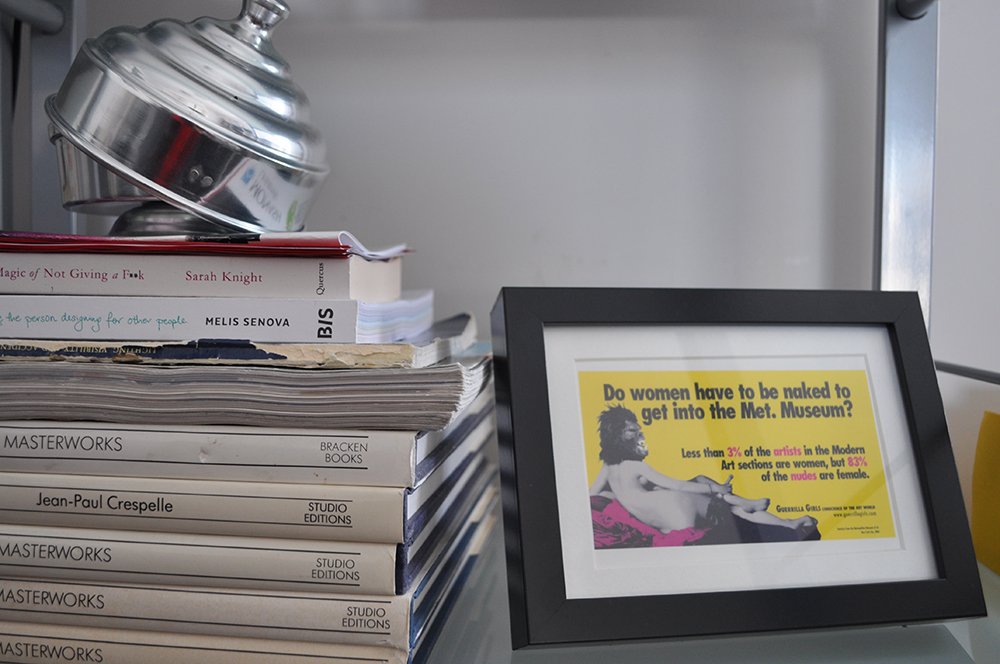Interview: Jane Connory, a champion for women in graphic design
In spring, tourists drive down Jane Connory’s street in Melbourne’s eastern suburbs to see the cherry blossoms bloom.
Inside her home, the walls are covered in art, including Guerrilla Girls' manifestos—an indication of Jane’s determination to increase visibility for women in Australian graphic design. On Jane’s desk sit treasured books about women in art and design such as Paula Sher and Guerrilla Girl Donna Kaz. From Jane’s uncluttered workspace she has views over tree-lined streets and neat rooftops.
Graphic design heroes
In addition to her role as the head of communications at the Design Institute of Australia (DIA), Jane interviews women in design for the program Broad Designs, broadcast on Joy FM, and is currently undertaking a Ph.D. at Monash University entitled, ‘Invisible: Women of Australian Graphic Design.’
In May 2017, at the Women in Design conference in Launceston, Jane launched the AfFEMation website to make her research available online. The website’s tag line—‘Making heroes of women in Australian graphic design’—states her intention to document the stories of women in design and highlight their contributions to the industry.
‘I am defining my conversation around not success, but significant contributions,’ said Jane. This means being recognised by industry peers but not necessarily having a large profile. Included in her research are interviews with designers including Jessie Stanley, Sue Allnutt, Kat Macleod and Chloe Quigley. Of particular note, Sue Allnutt has shown that women can run successful design businesses, have families and work nine to five. Fittingly, Sue is about to retire and hand the business over to her daughter.
Jane’s research highlights not only the work of women in design but also the importance of networking to sustain a thriving design practice within Australia. As shown on her website, all of the interviewees are in some way connected to one another. In such a small pool as Australia, the benefits of supporting one another instead of competing are evident.
A career in design
In the mid 1990s, Jane completed a graphic design degree at Monash and went straight into art direction in an ad agency. ‘The legacy of the “Madmen” era was still there,’ said Jane. With her strong belief in achieving success through merit and hard work, Jane was surprised to see that barriers still existed for women in advertising. ‘It was like hitting a brick wall,’ she said.
After working in agencies here in Australia, Jane worked in London and was frustrated to find a similar culture there. She found the expectations of long work hours incompatible with having a family, so she chose to redirect her career path. ‘I left and went into education as a career because I could schedule my time around pick ups and drop offs,’ she said.
Equipped with skills ranging from illustration to graphic design and branding, Jane worked in TAFE and higher education for nearly fifteen years. ‘It’s still a majority of women doing these design degrees and they still look to the industry and they still don’t see female mentors or role models. It was starting to weigh on my conscience,’ she said. Jane decided that she could contribute to changing the design industry culture and began her Ph.D. ‘I can do something about this and this is really important. These histories can’t just disappear,’ she said.
Jane has left her career in design education for the moment to focus on her role at the Design Institute of Australia whilst completing her PhD.
Jane Connory
Creating a legacy
Jane’s motivation in her work is to, as she explained, ‘Provide some sort of resource as a legacy for this next generation of women flooding the industry so they can figure out how they want to do it.’
With in-house design studios making a resurgence, Jane sees the value of design not purely for design itself, but as a way of thinking that can be applied across organisations to solve problems and innovate.
‘I think we have to be careful about how we define what a designer does because it shouldn’t be narrowed,’ said Jane. ‘Broadening that scope for women, especially, can leave those options a little bit more open about how you want to do it.’
In her previous role as a senior lecturer at Billy Blue College of Design, Jane would begin the first lecture by playing a recording of Fleetwood Mac’s ‘You Can Go Your Own Way,’ reminding new students that there are options within the design industry. ‘I always say to students, “What are your other passions in life? Is it music? Is it theatre? Look for in-house studios within those businesses.”’
Identifying mentors for young designers
Throughout Jane’s twenty-year career within design and education she has seen the importance of developing a framework to write inclusive history. She hopes that her research will help young designers find mentors and create networks to build their careers.
Jane’s advice to young women wanting to pursue a career in design is, 'Be resilient and stick at it if that’s what you want to do. It’s not easy. There are a lot of people doing it. Look for mentors; they’re out there. Find one and help them to help you up.’
For more about Jane’s work, visit affemation.com or follow her on Instagram (@invisibleinaus/)
Jenni Mazaraki is an artist, designer, writer and podcaster who helps women tell their stories. She is currently working on her first novel, which was shortlisted for the 2017 Deborah Cass Prize. You can see more of Jenni’s work at localstoryspace.com or on Instagram (@localstoryspace) or Facebook.
Photos by Jenni Mazaraki


